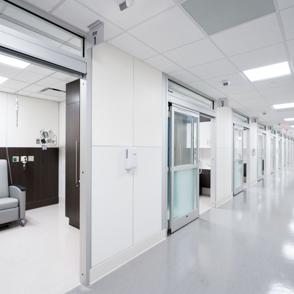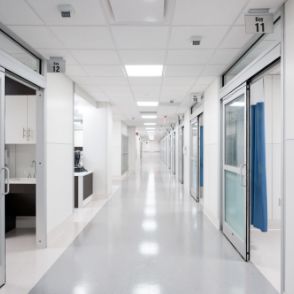The benefits of prefab construction result in a more sustainable and cost-effective solution to traditional building processes.
Architectural Wallsz utilise the benefits of prefab construction to build adaptable healthcare spaces and commercial premises. We lead the way in adaptive construction solutions in the UK and that’s why we’ve written this article to help highlight the increasing benefits of prefab construction, particularly in the healthcare and commercial industries.
What is Prefab Construction?
Prefab construction or prefabrication is the process of creating building components in a controlled, off-site setting. These components are then delivered to the construction site for quick and effective assembly.
Prefab construction decreases the reliance on on-site workers, reduces the possibility of errors and guarantees that each building component passes high quality standards before it arrives on the construction site.
Key Benefits of Prefab Construction
1. Speed and Efficiency
One of the most important benefits of prefab is the ability to swiftly complete projects. Traditional construction processes usually have long schedules due to the ordered pattern of on-site work and the possibility of delays caused by material shortages or coordination challenges.
Prefabrication, on the other hand, enables many project phases to take place at the same time. While the building components are manufactured off-site, site preparation can be completed at the same time and considerably shorten the entire project duration.
Our modular solutions are designed to be assembled quickly, enabling healthcare facilities and commercial spaces to be up and running in record time. This speed is especially important in the healthcare industry, where installations have a direct influence on patient care and operational efficiency.
2. Cost-Effectiveness
Prefab construction offers major cost savings compared to traditional methods. By shifting a large portion of the work off-site, construction companies can reduce on-site labour costs, minimise waste and avoid the costly delays often associated with on-site construction.
A factory’s regulated environment enables better resource management while minimising material waste, both of which contribute to lower overall project costs.
3. Quality Control
Another key benefit of prefab construction is the enhanced quality control it offers. Traditional building methods can be inconsistent due to the variety of on-site conditions, such as messiness and overcrowding, human error and material handling issues.
Prefabrication on the other hand takes place in a controlled factory environment, where every component is manufactured to precise specifications and put through rigorous quality tests before being sent to the site.
This level of quality control ensures that each building part meets the highest standards. As a result, we deliver consistent, high-quality solutions that meet the standards of the healthcare industry, where precision and reliability are critical.
4. Sustainability
Sustainability is becoming a more important issue in construction, and prefabrication is well-suited to fulfil the growing demand for green building practices. Off-site manufacturing is naturally more sustainable than traditional construction because it improves resource management, reduces waste and increases energy efficiency. Furthermore, prefab construction often uses eco-friendly materials and combines energy-efficient designs, reducing the environmental impact of the building process.
Our solutions also use recycled materials and are built in an efficient and environmentally friendly fashion. As a result, businesses that use prefab can lower their carbon footprint and contribute to a more sustainable future while still meeting construction goals.
5. Flexibility and Adaptability
One of the most noticeable benefits of prefab constructing is its innate flexibility and adaptability. Prefabricated structures are intended to be modular, which means they may be quickly modified, expanded or reconfigured as requirements change.
Architectural Wallsz designs adaptable environments that may grow and evolve alongside the company. Whether adding new rooms, redesigning existing spaces or introducing modern technologies, prefab construction enables seamless alterations without the need for important and disruptive renovations.
How Prefab Construction Differs from Traditional Building Methods
On-Site vs. Off-Site Construction
The primary difference between prefab construction and traditional building methods is where the work is done.
Traditional construction is mostly dependent on on-site labour, with all the related issues of coordinating different trades, managing logistics and dealing with weather-related delays.
Prefabrication takes the majority of the work off-site, where it may be accomplished more efficiently and with greater control over the finished product’s quality.
Labour and Material Ratios
Traditional construction often employs a 70/30 split, with 70% of the job being labour-intensive and 30% utilising materials. Prefabrication flips this approach to 30/70, drastically decreasing on-site labour needs and focussing on high-quality, pre-manufactured materials.
Design Flexibility
Prefab construction also provides more design freedom than traditional approaches. The modular design of prefabricated buildings provides for customisation and scalability, allowing organisations to develop facilities that are tailored to their individual requirements and can evolve with time. Such adaptability is a massive benefit in areas that demand frequent upgrades or expansions, such as healthcare and commerce.
The Benefits of Prefab Construction and Architectural Wallsz
The benefits of prefab construction are clear – it’s faster, less expensive, provides better quality control and is more sustainable and adaptable than traditional building methods.
As businesses demand better standards and greater efficiency, prefabrication is becoming the preferred way for producing modern, future-ready spaces.
Architectural Wallsz is proud to be at the forefront of this construction revolution. By integrating prefabrication, we help our clients reach their objectives with more efficiency, sustainability and flexibility.






Sorry, the comment form is closed at this time.